Libin Liu
Social Agent: Mastering Dyadic Nonverbal Behavior Generation via Conversational LLM Agents
Oct 06, 2025Abstract:We present Social Agent, a novel framework for synthesizing realistic and contextually appropriate co-speech nonverbal behaviors in dyadic conversations. In this framework, we develop an agentic system driven by a Large Language Model (LLM) to direct the conversation flow and determine appropriate interactive behaviors for both participants. Additionally, we propose a novel dual-person gesture generation model based on an auto-regressive diffusion model, which synthesizes coordinated motions from speech signals. The output of the agentic system is translated into high-level guidance for the gesture generator, resulting in realistic movement at both the behavioral and motion levels. Furthermore, the agentic system periodically examines the movements of interlocutors and infers their intentions, forming a continuous feedback loop that enables dynamic and responsive interactions between the two participants. User studies and quantitative evaluations show that our model significantly improves the quality of dyadic interactions, producing natural, synchronized nonverbal behaviors.
Graph Canvas for Controllable 3D Scene Generation
Nov 27, 2024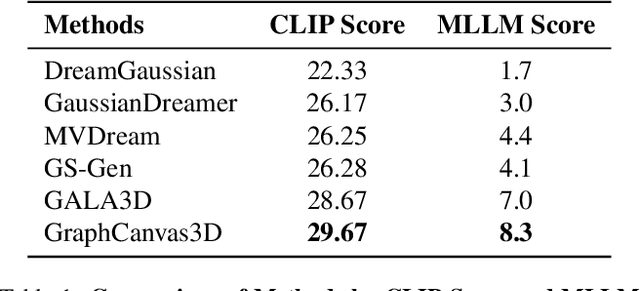

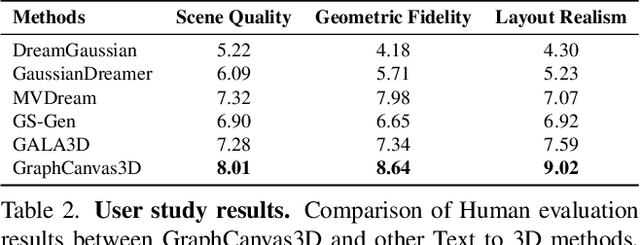
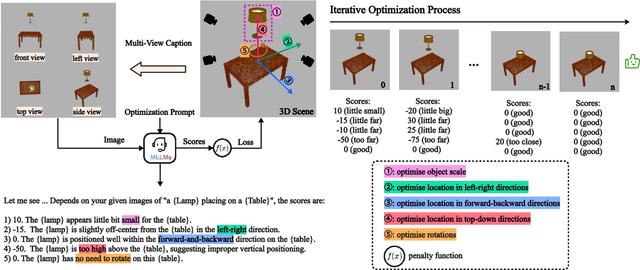
Abstract:Spatial intelligence is foundational to AI systems that interact with the physical world, particularly in 3D scene generation and spatial comprehension. Current methodologies for 3D scene generation often rely heavily on predefined datasets, and struggle to adapt dynamically to changing spatial relationships. In this paper, we introduce \textbf{GraphCanvas3D}, a programmable, extensible, and adaptable framework for controllable 3D scene generation. Leveraging in-context learning, GraphCanvas3D enables dynamic adaptability without the need for retraining, supporting flexible and customizable scene creation. Our framework employs hierarchical, graph-driven scene descriptions, representing spatial elements as graph nodes and establishing coherent relationships among objects in 3D environments. Unlike conventional approaches, which are constrained in adaptability and often require predefined input masks or retraining for modifications, GraphCanvas3D allows for seamless object manipulation and scene adjustments on the fly. Additionally, GraphCanvas3D supports 4D scene generation, incorporating temporal dynamics to model changes over time. Experimental results and user studies demonstrate that GraphCanvas3D enhances usability, flexibility, and adaptability for scene generation. Our code and models are available on the project website: https://github.com/ILGLJ/Graph-Canvas.
Semantic Gesticulator: Semantics-Aware Co-Speech Gesture Synthesis
May 17, 2024



Abstract:In this work, we present Semantic Gesticulator, a novel framework designed to synthesize realistic gestures accompanying speech with strong semantic correspondence. Semantically meaningful gestures are crucial for effective non-verbal communication, but such gestures often fall within the long tail of the distribution of natural human motion. The sparsity of these movements makes it challenging for deep learning-based systems, trained on moderately sized datasets, to capture the relationship between the movements and the corresponding speech semantics. To address this challenge, we develop a generative retrieval framework based on a large language model. This framework efficiently retrieves suitable semantic gesture candidates from a motion library in response to the input speech. To construct this motion library, we summarize a comprehensive list of commonly used semantic gestures based on findings in linguistics, and we collect a high-quality motion dataset encompassing both body and hand movements. We also design a novel GPT-based model with strong generalization capabilities to audio, capable of generating high-quality gestures that match the rhythm of speech. Furthermore, we propose a semantic alignment mechanism to efficiently align the retrieved semantic gestures with the GPT's output, ensuring the naturalness of the final animation. Our system demonstrates robustness in generating gestures that are rhythmically coherent and semantically explicit, as evidenced by a comprehensive collection of examples. User studies confirm the quality and human-likeness of our results, and show that our system outperforms state-of-the-art systems in terms of semantic appropriateness by a clear margin.
BAGS: Building Animatable Gaussian Splatting from a Monocular Video with Diffusion Priors
Mar 18, 2024



Abstract:Animatable 3D reconstruction has significant applications across various fields, primarily relying on artists' handcraft creation. Recently, some studies have successfully constructed animatable 3D models from monocular videos. However, these approaches require sufficient view coverage of the object within the input video and typically necessitate significant time and computational costs for training and rendering. This limitation restricts the practical applications. In this work, we propose a method to build animatable 3D Gaussian Splatting from monocular video with diffusion priors. The 3D Gaussian representations significantly accelerate the training and rendering process, and the diffusion priors allow the method to learn 3D models with limited viewpoints. We also present the rigid regularization to enhance the utilization of the priors. We perform an extensive evaluation across various real-world videos, demonstrating its superior performance compared to the current state-of-the-art methods.
A Spatial-Temporal Transformer based Framework For Human Pose Assessment And Correction in Education Scenarios
Nov 01, 2023Abstract:Human pose assessment and correction play a crucial role in applications across various fields, including computer vision, robotics, sports analysis, healthcare, and entertainment. In this paper, we propose a Spatial-Temporal Transformer based Framework (STTF) for human pose assessment and correction in education scenarios such as physical exercises and science experiment. The framework comprising skeletal tracking, pose estimation, posture assessment, and posture correction modules to educate students with professional, quick-to-fix feedback. We also create a pose correction method to provide corrective feedback in the form of visual aids. We test the framework with our own dataset. It comprises (a) new recordings of five exercises, (b) existing recordings found on the internet of the same exercises, and (c) corrective feedback on the recordings by professional athletes and teachers. Results show that our model can effectively measure and comment on the quality of students' actions. The STTF leverages the power of transformer models to capture spatial and temporal dependencies in human poses, enabling accurate assessment and effective correction of students' movements.
MoConVQ: Unified Physics-Based Motion Control via Scalable Discrete Representations
Oct 17, 2023Abstract:In this work, we present MoConVQ, a novel unified framework for physics-based motion control leveraging scalable discrete representations. Building upon vector quantized variational autoencoders (VQ-VAE) and model-based reinforcement learning, our approach effectively learns motion embeddings from a large, unstructured dataset spanning tens of hours of motion examples. The resultant motion representation not only captures diverse motion skills but also offers a robust and intuitive interface for various applications. We demonstrate the versatility of MoConVQ through several applications: universal tracking control from various motion sources, interactive character control with latent motion representations using supervised learning, physics-based motion generation from natural language descriptions using the GPT framework, and, most interestingly, seamless integration with large language models (LLMs) with in-context learning to tackle complex and abstract tasks.
Robust Dancer: Long-term 3D Dance Synthesis Using Unpaired Data
Mar 29, 2023



Abstract:How to automatically synthesize natural-looking dance movements based on a piece of music is an incrementally popular yet challenging task. Most existing data-driven approaches require hard-to-get paired training data and fail to generate long sequences of motion due to error accumulation of autoregressive structure. We present a novel 3D dance synthesis system that only needs unpaired data for training and could generate realistic long-term motions at the same time. For the unpaired data training, we explore the disentanglement of beat and style, and propose a Transformer-based model free of reliance upon paired data. For the synthesis of long-term motions, we devise a new long-history attention strategy. It first queries the long-history embedding through an attention computation and then explicitly fuses this embedding into the generation pipeline via multimodal adaptation gate (MAG). Objective and subjective evaluations show that our results are comparable to strong baseline methods, despite not requiring paired training data, and are robust when inferring long-term music. To our best knowledge, we are the first to achieve unpaired data training - an ability that enables to alleviate data limitations effectively. Our code is released on https://github.com/BFeng14/RobustDancer
GestureDiffuCLIP: Gesture Diffusion Model with CLIP Latents
Mar 28, 2023Abstract:The automatic generation of stylized co-speech gestures has recently received increasing attention. Previous systems typically allow style control via predefined text labels or example motion clips, which are often not flexible enough to convey user intent accurately. In this work, we present GestureDiffuCLIP, a neural network framework for synthesizing realistic, stylized co-speech gestures with flexible style control. We leverage the power of the large-scale Contrastive-Language-Image-Pre-training (CLIP) model and present a novel CLIP-guided mechanism that extracts efficient style representations from multiple input modalities, such as a piece of text, an example motion clip, or a video. Our system learns a latent diffusion model to generate high-quality gestures and infuses the CLIP representations of style into the generator via an adaptive instance normalization (AdaIN) layer. We further devise a gesture-transcript alignment mechanism that ensures a semantically correct gesture generation based on contrastive learning. Our system can also be extended to allow fine-grained style control of individual body parts. We demonstrate an extensive set of examples showing the flexibility and generalizability of our model to a variety of style descriptions. In a user study, we show that our system outperforms the state-of-the-art approaches regarding human likeness, appropriateness, and style correctness.
2D-Empowered 3D Object Detection on the Edge
Feb 18, 2023
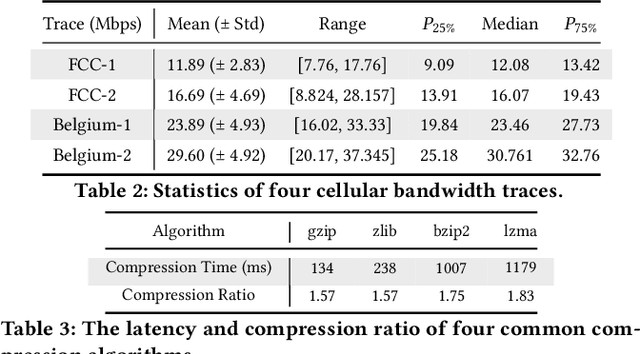
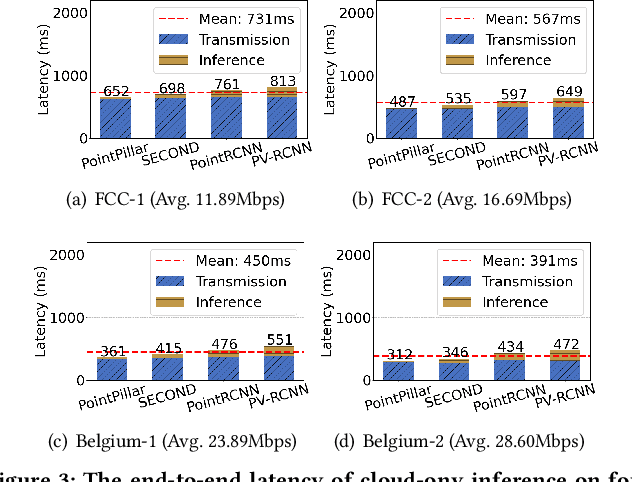
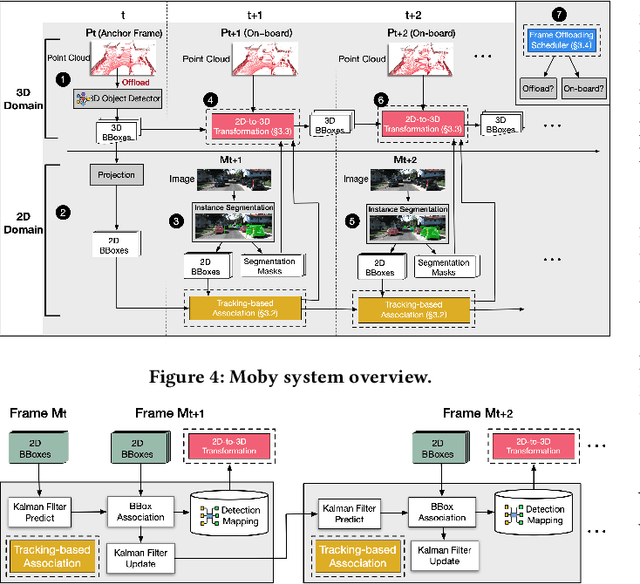
Abstract:3D object detection has a pivotal role in a wide range of applications, most notably autonomous driving and robotics. These applications are commonly deployed on edge devices to promptly interact with the environment, and often require near real-time response. With limited computation power, it is challenging to execute 3D detection on the edge using highly complex neural networks. Common approaches such as offloading to the cloud brings latency overheads due to the large amount of 3D point cloud data during transmission. To resolve the tension between wimpy edge devices and compute-intensive inference workloads, we explore the possibility of transforming fast 2D detection results to extrapolate 3D bounding boxes. To this end, we present Moby, a novel system that demonstrates the feasibility and potential of our approach. Our main contributions are two-fold: First, we design a 2D-to-3D transformation pipeline that takes as input the point cloud data from LiDAR and 2D bounding boxes from camera that are captured at exactly the same time, and generate 3D bounding boxes efficiently and accurately based on detection results of the previous frames without running 3D detectors. Second, we design a frame offloading scheduler that dynamically launches a 3D detection when the error of 2D-to-3D transformation accumulates to a certain level, so the subsequent transformations can draw upon the latest 3D detection results with better accuracy. Extensive evaluation on NVIDIA Jetson TX2 with the autonomous driving dataset KITTI and real-world 4G/LTE traces shows that, Moby reduces the end-to-end latency by up to 91.9% with mild accuracy drop compared to baselines. Further, Moby shows excellent energy efficiency by saving power consumption and memory footprint up to 75.7% and 48.1%, respectively.
MotionBERT: Unified Pretraining for Human Motion Analysis
Oct 12, 2022



Abstract:We present MotionBERT, a unified pretraining framework, to tackle different sub-tasks of human motion analysis including 3D pose estimation, skeleton-based action recognition, and mesh recovery. The proposed framework is capable of utilizing all kinds of human motion data resources, including motion capture data and in-the-wild videos. During pretraining, the pretext task requires the motion encoder to recover the underlying 3D motion from noisy partial 2D observations. The pretrained motion representation thus acquires geometric, kinematic, and physical knowledge about human motion and therefore can be easily transferred to multiple downstream tasks. We implement the motion encoder with a novel Dual-stream Spatio-temporal Transformer (DSTformer) neural network. It could capture long-range spatio-temporal relationships among the skeletal joints comprehensively and adaptively, exemplified by the lowest 3D pose estimation error so far when trained from scratch. More importantly, the proposed framework achieves state-of-the-art performance on all three downstream tasks by simply finetuning the pretrained motion encoder with 1-2 linear layers, which demonstrates the versatility of the learned motion representations.
 Add to Chrome
Add to Chrome Add to Firefox
Add to Firefox Add to Edge
Add to Edge